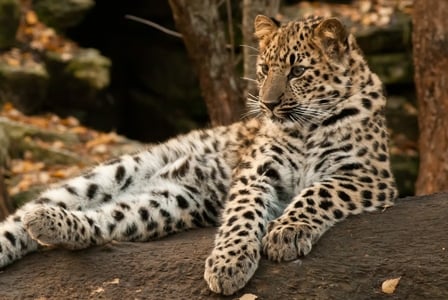
If youve ever thought that leopards are gazelle-chasing, savannah-loving Africa natives, then youve never heard of Amur leopards.
If you’ve ever thought that leopards are gazelle-chasing, savannah-loving Africa natives, then you’ve never heard of Amur leopards. It may seem like a tall tale, but these spotted felines have adapted to the chilly weather and harsh winters of Russia’s Far East.
Habitat
Amur leopards can be found stalking prey through the thick forests and steep mountains of their home range, which dots southern Russia, northeastern China, and the Korean peninsula.
Trivia
- Unlike other leopard species, these big cats can easily withstand some pretty chilly weather (which is useful, considering where they live). Their long legs help them move through the snow easily, and their uncharacteristically thick, pale fur can measure up to 3 in (7 cm) long during the winter months.
- They still have the same speed and agility as other leopards, though. They can reach speeds of up to 37 mph (60 kph) and are able to jump more than 19 ft (6 m) horizontally or 10 ft (3 m) straight up.
- As a result, they’re without a doubt the terror of any deer, boar, or hare that may look particularly tasty.
- While mostly solitary, these leopards are still better family members than most house cats out there—males may occasionally stay with a female to help her raise their young.
Why are they threatened?
Here’s one more piece of trivia for you—these stealthy predators have the dubious distinction of being one of the most endangered big cats in the world.
The hunting of these cats’ main prey has led them to attack local livestock, causing them to be viewed as pests and then shot by locals in order to protect domestic animals. They’re also the target of poachers looking to cash in on their valuable coats and their bones, which are used in traditional medicines. Because of these threats and others, the future of these leopards is murky at best.
There is good news, though. According to a census released in February 2015, the number of leopards living in Russia has almost doubled since 2007, bringing the number from about 30 of the big cats to 57.
This might seem like a bit of a hollow victory, considering how low these numbers still are—but conservation groups are ecstatic about the finding, claiming it to be a result of Russia’s new Land of the Leopard National Park, which was established in 2012. The park, which covers 60 percent of the cats’ current range, is considered proof that even the most critically endangered animals can recover if given the opportunity to do so.


